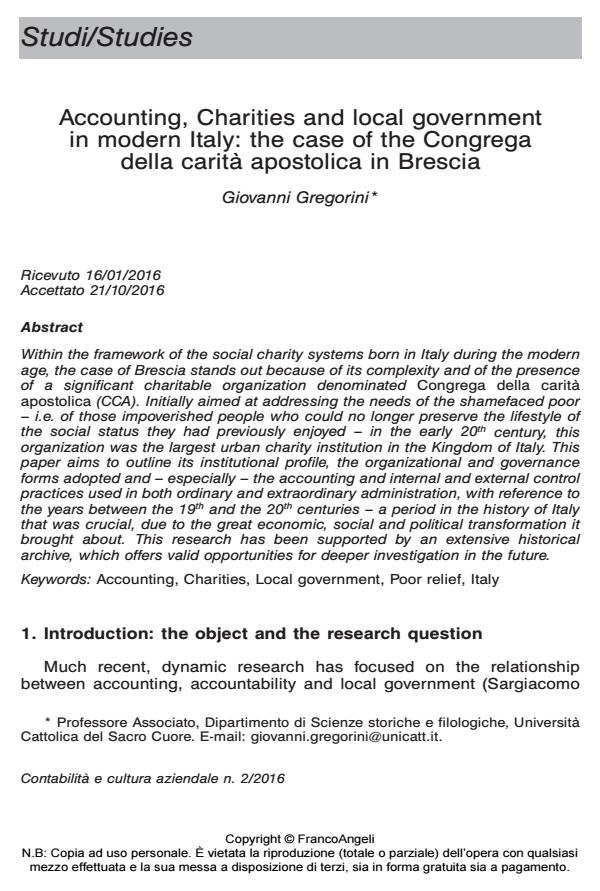Accounting, Charities and local government in modern Italy: the case of the Congrega della carità apostolica in Brescia
Journal title CONTABILITÀ E CULTURA AZIENDALE
Author/s Giovanni Gregorini
Publishing Year 2017 Issue 2016/2
Language English Pages 37 P. 7-43 File size 702 KB
DOI 10.3280/CCA2016-002002
DOI is like a bar code for intellectual property: to have more infomation
click here
Below, you can see the article first page
If you want to buy this article in PDF format, you can do it, following the instructions to buy download credits

FrancoAngeli is member of Publishers International Linking Association, Inc (PILA), a not-for-profit association which run the CrossRef service enabling links to and from online scholarly content.
Within the framework of the social charity systems born in Italy during the modern age, the case of Brescia stands out because of its complexity and of the presence of a significant charitable organization denominated Congrega della carità apostolica (CCA). Initially aimed at addressing the needs of the shamefaced poor - i.e. of those impoverished people who could no longer preserve the lifestyle of the social status they had previously enjoyed - in the early 20th century, this organization was the largest urban charity institution in the Kingdom of Italy. This paper aims to outline its institutional profile, the organizational and governance forms adopted and - especially - the accounting and internal and external control practices used in both ordinary and extraordinary administration, with reference to the years between the 19th and the 20th centuries - a period in the history of Italy that was crucial, due to the great economic, social and political transformation it brought about. This research has been supported by an extensive historical archive, which offers valid opportunities for deeper investigation in the future.
Keywords: Accounting, Charities, Local government, Poor relief, Italy
- Accounting and work in the charities: The case of an Italian institution in the nineteenth century Mario Nicoliello, Farzaneh Jalali Aliabadi, in Accounting History /2022 pp.215
DOI: 10.1177/10323732221086973 - La Verna Convent's accounting and non-accounting systems: Identifying the convent's stakeholders, their mutual relations, and their engagement in value creation Ilaria Elisa Vannini, Barbara Sibilio, in CONTABILITÀ E CULTURA AZIENDALE 2/2024 pp.59
DOI: 10.3280/CCA2024-002004
Giovanni Gregorini, Accounting, Charities and local government in modern Italy: the case of the Congrega della carità apostolica in Brescia in "CONTABILITÀ E CULTURA AZIENDALE" 2/2016, pp 7-43, DOI: 10.3280/CCA2016-002002